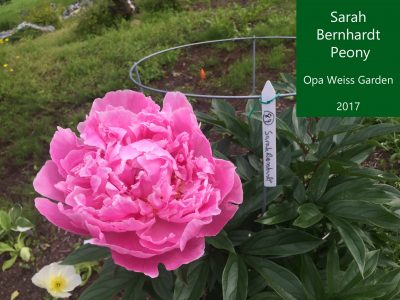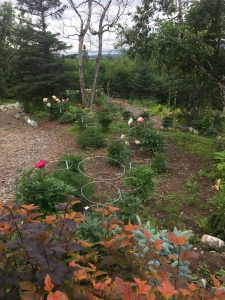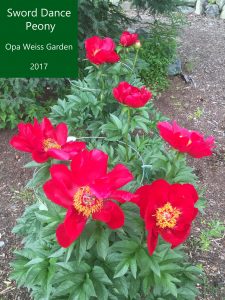By: Troy Weiss, Student at Alaska Master Gardening Class UAF On-Line, Fall 2017
Description
When I was planning my garden a few years ago, a more experienced gardening friend suggested I start growing peonies because they are hardy perennials that require little maintenance once established. I went online to research them, and instantly fell in love. I admired the amazing colors and sizes, and their ability to last as cut flowers. Peony plants can live for 75 to 100 years. They don’t produce flowers until they have matured 2-4 years in a location. However, I believe they are worth it. The flowers are beautiful, and I love walking through the garden and showing them off. 
My property in Southcentral Alaska is located at about 1000’ elevation, and has a North-West facing slope. I now have about 90 living peony plants, including about 60 replacements for plants that died in the first two years.
In this blog, I describe what I did and the results I got. I also share the variety performance data and some recommendations for new peony growers at higher elevations. Included below is a chart with data on 38 varieties that I have tried. It highlights which ones did well and which were disappointments. My results don’t represent statistically valid data sets; some varieties are really expensive, and I did not re-try expensive varieties that failed.
What I did

Due to the significant investment of time and money for growing peonies, the smart gardener should do some research before jumping into a huge peony garden. I researched online, and I was dazzled by the many gorgeous options. I began ordering varieties online that I found interesting. This was expensive because some wholesale bare root specimens can sell for $60-80 per plant.
After researching how to prepare the soil and plant peonies, I dedicated a large area of my garden to my new passion and went to work. During years 1 and 2, I only planted in the fall. After the second growing season, I also attended the Alaska Peony Growers Association (APGA) conference in Fairbanks. The conference had scholastic speakers working with Alaskan peony farmers; I learned a huge amount and discovered I had made many mistakes in my early efforts.
What Happened
After the first growing season, about 50% of the initial plants were dead, and the living plants were about half the expected height as advertised online. I replaced the dead plants with more economical varieties in pots from local nurseries. I was able to negotiate lower prices since I was making bulk purchases at the end of the season.
After the second growing season, half the plants were healthy and approaching advertised plant size. However, only 8 plants had bloomed! The mortality rate was 35% – still unacceptable. Again, I replaced the dead plants with cheaper varieties from local nurseries.
After the third growing season, I had much happier results. None of the plants died over the winter. 50% of the plants had flower buds, and there were 131 blooms from 40 different plants. The plants that were replaced in season 2 are smaller, but I expect they will develop with time.
Performance Data for Peony Varieties at higher elevations in Southcentral Alaska
My performance data includes 38 different varieties of peonies. In the table below, they are sorted by highest to lowest success rate. I define success rate by dividing the number of living plants by the total number of that variety. Living plants include healthy, weak, and diseased. I called a plant diseased if it had brown/purple or distorted leaves. The shading in the success rate column represents ranking based upon level of performance.

The rows I shaded with red are not recommended for higher elevations in Southcentral Alaska. The darker green rows represent the varieties I recommend to other peony enthusiasts. The lime green rows (Sword Dance, Carol, and Fern Leaf Hybrid) appear risky in my data; however, these flowers are some of my favorites, and I find them worth the risk. Below are some pictures of the middle group; hopefully you enjoy them too.
Recommendations
Here are my recommendations for growing peonies at higher elevations in Southcentral Alaska:
- Test your soil at least 1 year before planting in the fall. The lead time is necessary to get test results analyzed and make the recommended amendment changes before you plant. Here is a link on how to sample (Soil Sampling – CES University of Alaska Fairbanks), and here is a link on choosing laboratories to conduct the analysis (Recommendations on Soil Sampling Laboratories). Make sure to request an “Alaskan soil analysis” and to review the results with a CES expert. It is extremely important to adjust the pH with lime before putting roots in the ground. The soil analysis will likely be acidic in Alaska, and the analysis will provide how many pounds of lime you need per 100 sq. ft.
- Since a peony plant can live 75 years, it is important to amend a large hole for the long haul and let those amendments mellow before planting root stock. We’ve all heard it said, “Put a $25 plant in a million-dollar (well prepared) hole”. Here is a link on how to prepare a peony hole (How to Amend Soil for Peony – Cricket Hill Garden).
- You can buy expensive root stock online, but make sure it is proven in the area before stretching your budget. I had more success buying potted plants from reputable nurseries with experience in the varieties. It may be possible to get good deals at the end of the growing season when the peonies should actually be planted. Another potential root stock source is through local farmers. A farmer may add root stock to their orders or sell you plants they don’t want. Common varieties grown by Alaskan peony farmers include: Sara Bernhardt, Festiva Maxima, Duchess, Felix Supreme, and Mary Jo LeGare. Farmers consider good roots those that have 5 to 8 eyes; many of the ones I purchased online did not have this many eyes.
- Don’t plant too deep or too shallow. Plants should be planted with the highest eye of the root about 2′ or 2 thumb widths below surface or ground level (some recommend planting in mounds). The mass of the root can be much deeper, depending upon size. If too shallow, damage from freeze/thaw is possible. If too deep, the plants may make beautiful shrubs but never produce blooms. Here is a good link on how to correctly plant a peony root (How to Plant Peony – Adelman Peony Garden).
- Protect your peony plants with mulch or hay through the winter. Horticultural Consultant, Patricia Holloway, Ph.D., has data indicating that peony roots should not get below -4 F. Below this temperature, the cold winters damage the roots. What also kills roots is the freeze/thaw of ambient temperature cycles when we lack snow which provides thermal insulation. Adding 10-12′ of chopped leaves or hay on top of the peony mound will protect the plant from extremely cold temperatures, freeze/thaw periods, and low snow periods. The protective material should be removed or spread away from the crowns before the perennials sprout in the spring.
- Attend the Alaska Peony Growers Association (APGA) conference in Anchorage, January 25-28 2018. (APGA News Letter on 2018 Conference) You can be sure I’ll be there!
- Pray for the health of each little plant as you put it in the ground.
Additional Resources:
Peony – A Future Crop for Alaska? by Doreen Fitzgerald
Peonies for Field Cut Flower Production by Patricia S. Holloway, Janice T. Hanscom, and Grant E.M. Matheke


